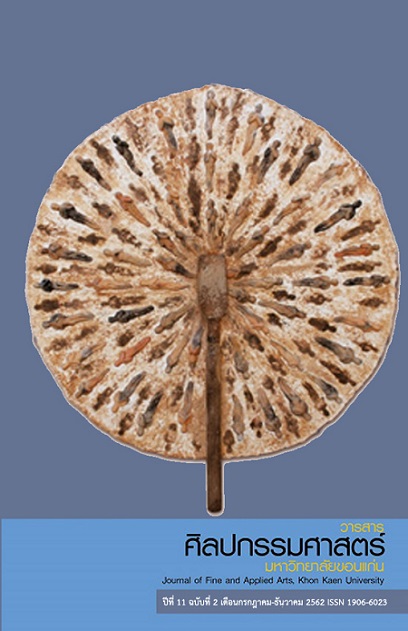The cultural and duty aspect changes of Ching Hon yuan textile in new economically mechanism era
Main Article Content
Abstract
This article is part of a qualitative research-The cultural and duty aspect changes of Lao Yuan textile in new economically mechanism era-the city of Chiang Hon, Xayabouli Sub District, Lao PDR is one of the study areas. The woven cloth of Chiang Hon, Xayabouli Sub District, Lao PDR joined the tribes of the Ming Dynasty during the evacuation of Chiang Saen. Woven fabrics also have a relationship with the way of life of the Chiang Hon tribe in all aspects, especially woven clothes. But there are applications and changes in the fashion. The culture and the role of the textile fabric in the present are different from the past. This is an apparently change when the government of Lao PDR has a policy including implementing the new economic and social development plan (NEM: New Economic Mechanism). The social conditions of the Lao PDR changed, then, the society of the tribal people changed. The result is the culture and the role of tribal textile changed. The differences between the culture and the role of cloth and the way of life of the tribe clearly between the past and present can be easily seen. If focus on the cornerstone of the factors that cause tribal social change, which also cause the change of culture and the role of textile fabrics. The internal factor is the acceptance of new cultures according to the time of the tribe. And the external factor is the development of social and economic conditions in the new era of Lao PDR.
Article Details
Content and information in articles published in the Journal of Fine and Applied Arts of Khon Kaen University is regarded as the opinion and sole responsibility of the author(s) directly; therefore, editors are not obliged to agree to or share any responsibility with regard to the content and information that appears within these articles.
All articles, information, content, image, etc. that have been published in the Journal of Fine and Applied Arts of Khon Kaen University is the copyright of the Journal of Fine and Appllied Arts of Khon Kaen University. Any person or organization who wishes to distribute all or parts of the articles for further dissemination or other usage must first receive permission from the Journal of Fine and Applied Arts of Khon Kaen University before proceeding to do so.
References
จรัสพิมพ์ วังเย็น. (2554). การออกแบบเครื่องนุ่งห่มเพื่อการพัฒนาสินค้าพื้นเมือง กรณีศึกษา ผ้าจกไทยวน จังหวัดราชบุรี. คณะอุตสาหกรรมสิ่งทอและออกแบบแฟชั่น มหาวิทยาลัยราชภัฏพระนคร.
นิเทศ ตินณะกุล. (2546). การเปลี่ยนแปลงทางสังคมและวัฒนธรรม. สำนักพิมพ์แห่งจุฬาลงกรณ์มหาวิทยาลัย.กรุงเทพฯ.
บุนจัน แก้ววิชา. (2560). สัมภาษณ์ . วันที่ 10 กันยายน 2560
ประชัน รักพงษ์. (2540). การศึกษาวัฒนธรรมพื้นบ้านไทลื้อในภาคเหนือของ สปป.ลาว.มหาวิทยาลัยราชภัฎเชียงใหม่:สำนักงานคณะกรรมการวัฒนธรรมแห่งชาติ.
วิบูลย์ ลี้สุวรรณ. (2550). สารานุกรมผ้า เครื่องถักทอ. กรุงเทพฯ: ด่านสุทธาการพิมพ์.
สมศักดิ์ ศรีสันติสุข. (2552). การศึกษาสังคมและวัฒนธรรม:แนวคิด วิธีวิทยา และทฤษฎี. พิมพ์ครั้งที่ 2. ขอนแก่น. มหาวิทยาลัยขอนแก่น.
____________ (2536). การเปลี่ยนแปลงทางสังคมและวัฒนธรรม:แนวทางการศึกษา วิเคราะห์ และวางแผน. ขอนแก่น. มหาวิทยาลัยขอนแก่น.
สรัสวดี อ๋องสกุล. (2557). ประวัติศาสตร์ล้านนา.พิมพ์ครั้งที่ 10.กรุงเทพฯ: อัมรินทร์พริ้นติ้งแอนด์พับลิชชิ่ง.
สุเนตร โพธิสาร. (2558). ประวัติศาสตร์ลาว. ขอนแก่น: กองทุนผลิตตำราคณะศิลปกรรมศาสตร์ มหาวิทยาลัยขอนแก่น.
Lao Front for National Construction. (2008). The Ethnic Group in Lao P.D.A.Department of Ethnic Affaire.


